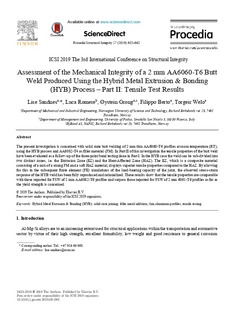| dc.contributor.author | Sandnes, Lise | |
| dc.contributor.author | Romere, Luca | |
| dc.contributor.author | Grong, Øystein | |
| dc.contributor.author | Berto, Filippo | |
| dc.contributor.author | Welo, Torgeir | |
| dc.date.accessioned | 2019-08-27T12:34:53Z | |
| dc.date.available | 2019-08-27T12:34:53Z | |
| dc.date.created | 2019-08-26T07:59:22Z | |
| dc.date.issued | 2019 | |
| dc.identifier.citation | Procedia Structural Integrity. 2019, 17 632-642. | nb_NO |
| dc.identifier.issn | 2452-3216 | |
| dc.identifier.uri | http://hdl.handle.net/11250/2611226 | |
| dc.description.abstract | The present investigation is concerned with solid state butt welding of 2 mm thin AA6060-T6 profiles at room temperature (RT), using the HYB process and AA6082-T4 as filler material (FM). In Part II of this investigation the tensile properties of the butt weld have been evaluated as a follow-up of the three-point bend testing done in Part I. In the HYB case the weld can be sub-divided into two distinct zones, i.e. the Extrusion Zone (EZ) and the Heat-Affected Zone (HAZ). The EZ, which is a composite material consisting of a mix of a strong FM and a soft HAZ material, displays superior tensile properties compared to the HAZ. By allowing for this in the subsequent finite element (FE) simulations of the load-bearing capacity of the joint, the observed stress-strain response of the HYB weld has been fully reproduced and rationalized. These results show that the tensile properties are comparable with those reported for FSW of 2 mm AA6082-T6 profiles and surpass those reported for FSW of 2 mm 6061-T6 profiles as far as the yield strength is concerned. | nb_NO |
| dc.language.iso | eng | nb_NO |
| dc.publisher | Elsevier | nb_NO |
| dc.rights | Attribution-NonCommercial-NoDerivatives 4.0 Internasjonal | * |
| dc.rights.uri | http://creativecommons.org/licenses/by-nc-nd/4.0/deed.no | * |
| dc.title | Assessment of the Mechanical Integrity of a 2 mm AA6060-T6 Butt Weld Produced Using the Hybrid Metal Extrusion & Bonding (HYB) Process – Part II: Tensile Test Results | nb_NO |
| dc.type | Journal article | nb_NO |
| dc.type | Peer reviewed | nb_NO |
| dc.description.version | publishedVersion | nb_NO |
| dc.source.pagenumber | 632-642 | nb_NO |
| dc.source.volume | 17 | nb_NO |
| dc.source.journal | Procedia Structural Integrity | nb_NO |
| dc.identifier.doi | doi.org/10.1016/j.prostr.2019.08.085 | |
| dc.identifier.cristin | 1718548 | |
| dc.description.localcode | © 2019. This manuscript version is made available under the CC-BY-NC-ND 4.0 license http://creativecommons.org/licenses/by-nc-nd/4.0/ | nb_NO |
| cristin.unitcode | 194,64,94,0 | |
| cristin.unitcode | 194,66,35,0 | |
| cristin.unitcode | 194,64,92,0 | |
| cristin.unitname | Institutt for vareproduksjon og byggteknikk | |
| cristin.unitname | Institutt for materialteknologi | |
| cristin.unitname | Institutt for maskinteknikk og produksjon | |
| cristin.ispublished | true | |
| cristin.fulltext | original | |
| cristin.qualitycode | 1 | |

